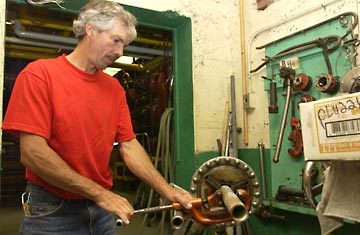Table of Contents
Does Higher Education in America Cost Too Much?
One of the major factors driving the cost of higher education is the need to provide up-to-date technology at as low a user:equipment ratio as feasible.
It's a question that is on many people's minds, and it was the theme of one session at Sunday morning's forums. Principal moderator was Trustee Sabra Bartlett '74, with the assistance of Trustee Ed Amsler '68.
Amsler opened the discussion by citing the assigned article “Why Can't a College Be More Like a Firm?” by Gordon Winston. He reiterated Winston's contention that although there are fundamental differences between for-profit and not-for-profit entities—for example, not-for-profits, including colleges and universities, can provide “donative subsidies” to their “customers”--both need to consider costs and revenues. Amsler posed the question, “What drives a university's costs?” and called upon Trustee Dekkers Davidson '78 to start the conversation.
“It all comes down to people and facilities,” Davidson said. Participants disagreed over whether “buyers” of higher education know very much about the product and, therefore, use price to gauge quality. Some expressed concern about pegging our price too low, contributing to what the Winston article refers to as “peer effect,” wherein the value of a product is affected by the perceived quality of those who buy it—in other words, “Who else is going to St. Lawrence?”
Discussion about costs continued, touching on technology, building maintenance and capital improvements. Melissa Wilson MacGregor '98 mentioned the costs associated with St. Lawrence's expanding athletic and extracurricular opportunities and the facilities that support them. An important goal, Bartlett said, is to “provide a more intensive, hands-on, ‘enriched' education at St. Lawrence,” which is costly.
The need to provide nutritious and healthful food in quantities adequate to feed energetic young people is a significant portion of the cost of higher education today.
Amsler reminded the group that the discussion isn't about just St. Lawrence, but about liberal arts higher education nationwide. Davidson shifted the conversation toward the value of higher education, asking “Why apologize?” He observed that the higher education “product” has a very high perceived value, that there is good demand and that most students enjoy some level of discount. “Higher education is a bargain,” he said.
Amsler pointed out that the actual cost of a St. Lawrence education is about $47,000 whereas the comprehensive fee about $36,000, and the average actual payment is about $19,000, which works out to around $104 a day—quite a bargain, Vice President for University Advancement Mike Archibald noted, since it buys a college education and all the amenities that go with it. Archibald explained St. Lawrence's 35% discount rate, saying that very wealthy schools can, through endowment earnings, provide extraordinary subsidies (discounts), some spending millions to shape a class.
Trustee Cheryl Grandfield '73 noted that investments in technology can result in long-term cost savings for “regular businesses,” but colleges and universities typically see technology as an educational tool, not a cost-reducer.
Amsler then directed the conversation toward resources. New trustee Sharee Freeman '76 listed “tuition, donations and ‘revenue enhancing activities,'” such as Brewer Bookstore. Amsler noted that tuition is supplemented by state and federal aid programs and Jim MacGregor '98 argued that those support programs have not risen in stride with tuition and, as a consequence, play an ever-decreasing role. “Colleges have taken up the slack through need-based financial aid,” Archibald interjected.
After a brief wrap-up, three break-out discussion sections were formed: Resources, Subsidies, and Value vs. Cost of Higher Education. When the large group reconvened, each section's spokesperson offered a quick recap of the conversations:
Resources:
Costs will continue to rise and St. Lawrence must continue offering aid. As a consequence, endowment expansion and increased giving will be essential. Alumni will need to be more active “ambassadors” for St. Lawrence. One participant remarked, “We're awfully shy at events.”
One of the relatively hidden costs of higher education is that incurred through the need to maintain the physical plant and infrastructure.
Subsidies:
Wealthy schools will continue to provide subsidies. “They'll literally give away education,” Davidson said, adding that, to compete effectively, St. Lawrence will need to offer small classes, close student/faculty contact and an expanded alumni network. “An energized alumni body is St. Lawrence's best hope,” he said.
Value vs. Cost:
St. Lawrence has a continued need to market its strengths, such as students benefiting from real-world experience through fieldwork in many disciplines. One participant spoke proudly of St. Lawrence undergraduates who have published papers, saying, “We need to get our higher academic profile ‘out there.' [Then] the alumni network will self-perpetuate.”
The session wrapped up with a list of questions for President Sullivan:
• How will St. Lawrence constrain costs?
• How will St. Lawrence enhance its value?
• How will St. Lawrence continue to support subsidies?
• How will St. Lawrence preserve its defining characteristics?
“If we're moving up the food chain, we're going to cost more. How do we continue to provide educational opportunities for those who need them?” asked Davidson at the close of the session.
Reported by Ken Alger
Graphic DesignerAt the plenary:
Trustee Bartlett condensed these four questions into one: “How does St. Lawrence increase perceived value as it relates to cost?”
President Sullivan: “Many of you have heard me speak of Thorstein Veblen's Principle of Cumulative Advantage . Essentially, those who have more, do better, and continue to accumulate quality and value at a rate faster than those who need to come from behind. However, those same institutions tend to be more rooted in ways of behavior that have traditionally been successful, so they may not be as responsive to opportunities. I believe it's possible to catch up, even leapfrog over, those who may be perceived as ahead of us. We must work harder, be more devoted, more committed, more idealistic about the potential of our work. If we can sustain hustle, the word of mouth will be the most powerful marketing tool we have. Our job will be to get the messages to the people who matter most in our work.”
Reading:
-Gordon C. Winston, “Why Can't a College Be More Like a Firm?”


